SchoolsRose-Hulman Institute of Technology, Indiana State University & Saint Mary-of-the-Woods College
Rose-Hulman Institute of Technology5500 Wabash Ave, Terre Haute, IN
Rose-Hulman Institute of Technology is now the number one college or university that offers the bachelor's or master's degree as its top degree in engineering, and it has held this ranking for ten consecutive years now according to U.S. News and World Report. The excellence that is now a tradition at Rose starts with Rose's history which dates back to 1874. This is the year when Chauncey Rose decided to create a school for engineers because he wanted more engineers available while building the railroad through Terre Haute. He donated money along with the land at the corner of 13th Street and Locust Street to build the Terre Haute School of Industrial Science. Mr. Rose did not want the school named after him, but nobody would listen and it soon became Rose-Polytechnic Institute. The first day of classes was held March 7, 1883 with a student population of 25 young men.
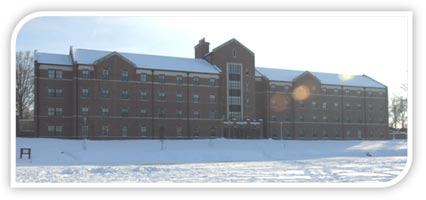 By 1917 the student body had grown, and the school building was no longer adequate for the size of the student body. The Hulman family donated their 123 acre farm on Highway 40 for the expansion of Rose-Poly. This new location was large enough to provide a dorm, Deming Hall, for out of town students as well as the needed classrooms for 300 students.
By 1917 the student body had grown, and the school building was no longer adequate for the size of the student body. The Hulman family donated their 123 acre farm on Highway 40 for the expansion of Rose-Poly. This new location was large enough to provide a dorm, Deming Hall, for out of town students as well as the needed classrooms for 300 students.
The school continued to grow both in population and the social aspect which led to fraternities. In 1883 fraternities became a part of Rose-Poly with Alpha Tau Omega being chartered in 1893. Two years later Sigma Nu was chartered, in 1900 PIES, which is now Lambda Chi Alpha, and in 1907 Theta Xi. In the 1960's and 1970's a student recreation facility was added along with four new dormitories and the Fraternities Triangle, Phi Gamma Delta, and Delta Sigma Phi were constructed at the east end of campus. In 1988 Pi Kappa Apha became a chartered fraternity.
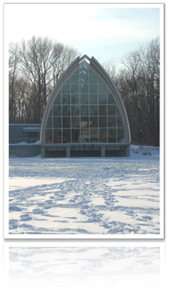 With continuing donations and support Rose-Poly grew tremendously. The Hulman family continued to donate their fortune and the Hulman Union was built in 1966. Five years later, Anton Hulman Jr. and his wife wanted to continue the family tradition of philanthropy toward Rose-Poly so they gave the assets of their family fortune as well which was valued at over 11 million dollars. The School decided to rename in honor of the Hulman family, and became Rose-Hulman Institute of Technology. The school received a $4.75 million grant from The Fanklin W. Olin Foundation to construct a new classroom/ laboratory building which began in 1983. A few years later funds for a new administration building came from the George Hadley family.
With continuing donations and support Rose-Poly grew tremendously. The Hulman family continued to donate their fortune and the Hulman Union was built in 1966. Five years later, Anton Hulman Jr. and his wife wanted to continue the family tradition of philanthropy toward Rose-Poly so they gave the assets of their family fortune as well which was valued at over 11 million dollars. The School decided to rename in honor of the Hulman family, and became Rose-Hulman Institute of Technology. The school received a $4.75 million grant from The Fanklin W. Olin Foundation to construct a new classroom/ laboratory building which began in 1983. A few years later funds for a new administration building came from the George Hadley family.
In 1991 the Board of Management decided to allow any qualified student to study at Rose-Hulman, and thus females were admitted for the first time in the 1995-1996 school year. That same year was the first year the Rose required all students to purchase a laptop, becoming one of the first schools to do so. The first year that females were on campus, two women's fraternities became colonies, Chi Omega and Delta Delta Delta. In 2006 the third women's fraternity, Alpha Omicron Pi, became a colony.
Today there 1,840 undergraduates students studying math, science, or engineering at Rose-Hulman Institute of Technology. There are 10 residence halls on campus which can provide housing for 1,100 students. Rose competes in Division III athletics with 14 varsity sports. There are 16 majors of study to choose from and 31 minors.
Indiana State University200 North Seventh Street, Terre Haute, IN
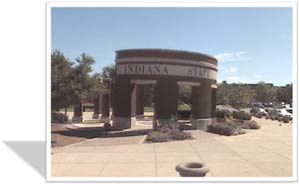 Indiana State University is one of “The Best in the Midwest” and has been for five consecutive years now according to the Princeton Review. ISU’s history goes back to December 20, 1865 when the General Assembly decided to build a normal school. Terre Haute was chosen for the site of the new school because they contributed $50,000 to the school and promised to always pay one half of the expenses for building and ground repair. William Albert Jones, the first president of Indiana State Normal School, welcomed 21 new students on the first day of classes, January 6, 1870. These students were all studying to become elementary school teachers, and they formed the Eclectic Society, the first literary society.
Indiana State University is one of “The Best in the Midwest” and has been for five consecutive years now according to the Princeton Review. ISU’s history goes back to December 20, 1865 when the General Assembly decided to build a normal school. Terre Haute was chosen for the site of the new school because they contributed $50,000 to the school and promised to always pay one half of the expenses for building and ground repair. William Albert Jones, the first president of Indiana State Normal School, welcomed 21 new students on the first day of classes, January 6, 1870. These students were all studying to become elementary school teachers, and they formed the Eclectic Society, the first literary society.
The school continued to grow over the years. In 1873 Chauncey Rose donated $4,000 to buy books for the library. Also in the 1870’s four-year teaching course and the Alumni Association were established. In the 1880’s more departments were added which included the Department of Art, the Department of Natural Science, and the Department of Music.
In 1888 a fire completely destroyed Indiana State Normal School with a loss estimated around $225,000 and no insurance coverage. The City of Terre Haute gave $50,000 and the General Assembly gave $100,000 to rebuild the school which was reopened in September 1889.
Sports soon became part of Indiana State Normal School. In 1889 the first track and field competitions were held. Five years later football and basketball were introduced to the school. By 1895 they were members of the Indiana Intercollegiate Athletic Association.
 The campus soon became very social with the formation of the Women’s League in 1897 to organize sorority activities. In 1901 the Forum Society (later T.K.E) became the first social fraternity on campus.
The campus soon became very social with the formation of the Women’s League in 1897 to organize sorority activities. In 1901 the Forum Society (later T.K.E) became the first social fraternity on campus.
Indiana State Normal School continued to improve their academics. The entrance and graduation requirements were changed in 1907 to be similar to those of Indiana University. In 1909 the color Blue and White became the official school colors. Later the Department of Domestic Economy, the Department of Romance Lanuages, the Department of Commerce, and the Department of Industrial Art were established.
In 1922 the athletic teams became known as the Sycamores. This same year a new grading scale was established using A, B, C, D, F instead of P+, P, P-, NP. The next year all of the departments reorganized to condense from 27 departments to 13 departments. In 1927 a Graduate School was organized to allow students to further their education. Indiana State Normal School became Indiana State Teachers College in 1929.
Through the 1930’s the Department of Alumni Relations, the Department of Public Relations, and the Philosophy Department were created. The first homecoming queen was also chosen. In 1945 Anton Hulman Jr. donated 47 acres of land for an athletic facility but Indiana State Teachers College never used it, and the land was later sold to the City of Terre Haute. In 1946 the first Student Government Association was formed.
Over the years, new buildings were added to house the different departments. Campus life grew and flourished. Alumni activities were put in place to celebrate homecoming activities and other festivals. New dormitories have been added along with cafeterias and gymnasiums. In 1961 the college was renamed Indiana State College. In 1965 it was renamed again to the present name of Indiana State University. Now ISU is organized into five colleges and one school which are the College of Arts and Sciences, the College of Business, the College of Education, the School of Graduate Studies, the College of Nursing, Health, and Human Services, and the College of Technology.
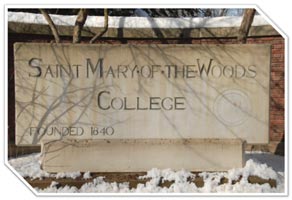
Saint Mary-of-the-Woods CollegeSaint Mary-of-the-Woods, IN
Saint Mary-of-the-Woods College is the nation’s oldest Catholic Liberal Arts College for Women. Their history began with Mother Theodore Guerin. The Bishop of Vincennes asked the sisters of Providence to create an academy for women in Indiana. Mother Theodore Guerin led the sisters on their journey that started in France in 1840.
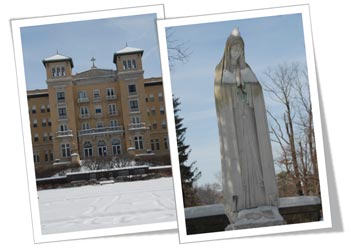 Saint Mary-of-the-Woods College was the first women’s college to offer journalism, secondary education, home economics and secretarial science. It has grown to be the home of 1,700 students with ov courses and the first to offer degree work in er 50 majors available. Their athletics include basketball, softball, equestrian, soccer, and as of 2008, golf. In 2009 the Pomeroys will also compete in cross country. They were named the Pomeroys in memory of Mary Joseph Pomeroy, an alumna and faculty who advocated physical fitness.
Saint Mary-of-the-Woods College was the first women’s college to offer journalism, secondary education, home economics and secretarial science. It has grown to be the home of 1,700 students with ov courses and the first to offer degree work in er 50 majors available. Their athletics include basketball, softball, equestrian, soccer, and as of 2008, golf. In 2009 the Pomeroys will also compete in cross country. They were named the Pomeroys in memory of Mary Joseph Pomeroy, an alumna and faculty who advocated physical fitness.
Some of the traditions at the Woods include Ring Day, Senior Crown, and Big Sis/ Lil Sis. The ring worn by the Woodsies after graduation has oak leaves that are symbolic of knowledge gained at SMWC, six acorns representing the College's founders, and the insignia that is carved in black onyx. The Senior Crown is received a week before graduation signifying that their acorn has grown into an oak tree. The oak tree is a symbol for strength and durability of character.
